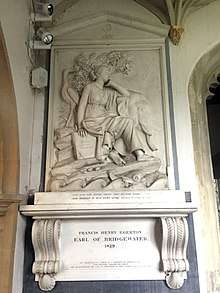Francis Egerton, 8th Earl of Bridgewater
Francis Henry Egerton, 8th Earl of Bridgewater, FRS, FSA (11 November 1756 – 11 February 1829), known as Francis Egerton until 1823, was a noted British eccentric from the Egerton family and supporter of natural theology.[1]
.svg.png)
Egerton was a Church of England clergyman who held the rectories of Myddle and Whitchurch in Shropshire, but the duties were performed by a proxy. He succeeded his brother John in the earldom in 1823, and spent the latter part of his life in Paris. He was a fair scholar, and a zealous naturalist and antiquarian. When he died in February 1829 the earldom became extinct.[2]
Early life
Egerton was a son of John Egerton, Bishop of Durham and Anne Sophia Grey.[3][lower-alpha 1] He was educated at Eton and Christ Church, Oxford, and became a fellow of All Souls in 1780, and Fellow of the Royal Society in 1781.[2] He inherited his title and a large fortune in 1823 from his brother, the 7th Earl.[3]
Career

Egerton was eccentric. According to the Parisian police, Egerton kept dogs and cats in his house which he dressed as ladies and gentlemen and would take them with him in his carriage.[3] he kept partridges and pigeons with clipped wings in his garden, allowing him to shoot them despite failing eyesight. He never married, and upon his death, his title became extinct.[2] He was buried at Little Gaddesden, Hertfordshire.[4]
In the early 17th century, Thomas Egerton, 1st Viscount Brackley, had purchased Ashridge House, one of the largest country houses in England, from Queen Elizabeth I, who had inherited it from her father who had appropriated it after the dissolution of the monasteries in 1539. Ashridge House served the Egerton family as a residence until the 19th century. The Egertons later had a family chapel (the Bridgewater Chapel) with burial vault in Little Gaddesden Church,[5] where many monuments commemorate the Dukes and Earls of Bridgewater and their families.[4]
Arts and science
He was invested as a Fellow of the Royal Society (F.R.S.) on 8 November 1781 and as a Fellow of the Society of Antiquaries of London (F.S.A.) on 31 March 1791.[3]
In 1812 he wrote "Description du Plan Incliné Souterrain" about the underground canals of the Worsley Navigable Levels, coal mines in Worsley, Greater Manchester, part of the Bridgewater estate.[6]
Death and bequests
At his death his titles became extinct.[2]
He bequeathed to the British Museum the valuable Egerton Manuscripts,[2] consisting of 67 manuscripts dealing with the literature of France and Italy, and £12,000[2] to establish the Egerton Fund from which the Museum could purchase additional manuscripts. More than 3800 manuscripts have been purchased using the Egerton fund.
He also left £8,000 at the disposal of the president of the Royal Society, to be paid to the author or authors who might be selected to write and publish 1000 copies of a treatise "On the Power, Wisdom and Goodness of God, as manifested in the Creation". The resulting eight Bridgewater Treatises first appeared between 1833 to 1840, and afterwards in Bohn's Scientific Library.[2]
See also
Notes
- Egerton's maternal grandparents were Henry Grey, 1st Duke of Kent and his second wife Sophia Bentinck. Sophia was a daughter of William Bentinck, 1st Earl of Portland and Anne Villiers. Anne was a daughter of Sir Edward Villiers and his first wife Frances Howard. She was also a sister of Edward Villiers, 1st Earl of Jersey.
- Mosley 2003, pp. 1232-12323.
- Chisholm 1911, p. 558.
- Lundy 2011, p. 15192 § 151911 cites Cokayne 2000, p. 316
- Monuments 2015.
- Bridgewater Chapel 2015.
- Egerton 1812.
References
- Egerton, Francis Henry (1812), Description du plan incliné souterrain, au bureau des Annales des Arts et Manufactures, rue J.J. Rouseau, n. 1, Imprimerie de Chaignieau Aîné
- Bridgewater Chapel, Little Gaddesden Church, 10 February 2015, retrieved 11 April 2017
- Monuments, Little Gaddesden Church, 10 February 2015, retrieved 11 April 2017
- Lundy, Darryl (1 May 2011), Francis Henry Egerton, 8th Earl of Bridgwater, p. 15192 § 151915, retrieved 11 April 2017 cite:
- Cokayne, G.E.; et al., eds. (2000), The Complete Peerage of England, Scotland, Ireland, Great Britain and the United Kingdom, Extant, Extinct or Dormant, II (reprint in 6 volumes ed.), Gloucester, U.K.: Alan Sutton Publishing, p. 316
- Mosley, Charles, ed. (2003), Burke's Peerage and Baronetage, 1 (106th in 2 volumes ed.), Crans, Switzerland: Burke's Peerage, pp. 1232–1233
Attribution:
- Chisholm, Hugh, ed. (1911), , Encyclopædia Britannica, 4 (11th ed.), Cambridge University Press, p. 558
Further reading
| Wikimedia Commons has media related to Francis Henry Egerton, 8th Earl of Bridgewater. |

- Caufield, Catherine (1981), The Emperor of the United States and Other Magnificent British Eccentrics, Routledge & Kegan Paul, pp. 77–79, ISBN 0-7100-0957-7
- The Ninth Bridgewater Treatise
| Peerage of England | ||
|---|---|---|
| Preceded by John William Egerton |
Earl of Bridgewater 2nd creation 1823–1829 |
Extinct |